Slavery started in Haiti with the arrival of Columbus. Met with friendliness, welcoming gifts, and delicious local fritters called Accra or Akra, he described the native Arawak Taino people as “tractable, and easily led; they could be made to grow crops and build cities” (Mellzer, Slavery: A World History, 1971). And the gentle, helpful natives were forced to do just that, as well as work in the gold and copper mines. Nobody knows how many Taino people had lived on the island before Columbus “discovered” them – nobody bothered counting! – but about a third of the population died of hard labor and European diseases within the first two years, and estimated 92% disappeared during the first ten years (Thomas, The Slave Trade: The Story of the Atlantic Slave Trade: 1440–1870, 2013).

Don Diego Columbus, the 2nd Admiral of the Indies, 2nd Viceroy of the Indies and 4th Governor of the Indies “by right of his father’s discovery” (as well as by dint of being married to King Ferdinand’s second cousin – nepotism works!) was forced to bring the African slaves to the island in 1505 due to the drastic decimation of Taino population. “Someone had to work the plantations, after all,” – he reasoned.
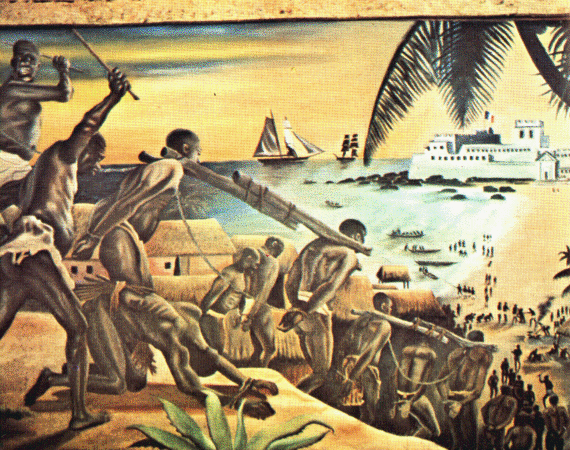
It marked the beginning of three hundred years of brutality the likes of which is hard to find anywhere else. No wonder slave uprising were frequent! Thousands of slaves escaped into the mountains, forming communities called maroon (reddish-brown color). Their knowledge of native plants afforded a unique weapon of resistance – poison. Fear of being poisoned spread among plantation owners like wildfire, prompting the French King to issue a ban on poisoning. The maroons’ reaction was to use another tactic – arson. Having been used by the gentle Tainos to prepare feasts of welcome, fires now burned bright, consuming slaveholders together with their livestock and properties. Eventually, the flame of resistance culminated in a successful revolution (1791 – 1804), the first and the only such event in the world that gave birth to an independent nation.
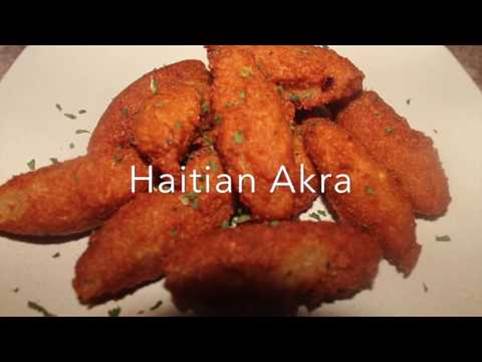
The same delicious fritters probably made for Columbus by the hospitable Taino natives are still popular in Haiti, and my student Rose Andrelle Pierre kindly shared this recipe and photos.
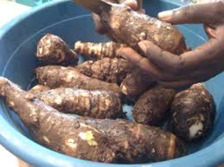
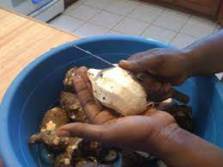
It is really so simple that you start wondering how something so simple could be so good! You need about 8 – 10 malanga roots, and you peel them the way you peel any root vegetable. An important fact about malanga, AKA yauta, is that it is nightshade and gluten free. Grate your malanga on a fine grater and put it aside.



The secret of accra is in seasoning: green pepper, hot peppers, lots of garlic, scallions, parsley, and some bouillon cubes or soup powder. Haitians prefer Maggi brand, but any soup powder will add the right flavor (note: Maggi is not kosher). Add some salt and hot sauce, if you are so inclined, and apply elbow grease to pound it into paste with your mortar and pestle. What – you don’t have a mortar and pestle? Don’t worry, says Andrelle, you obtain the same results by using your trusty blender.
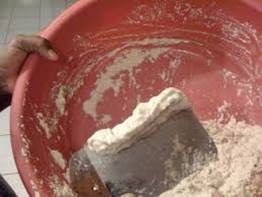
Mix the seasoning paste with grated malanga, and you are ready to fry.
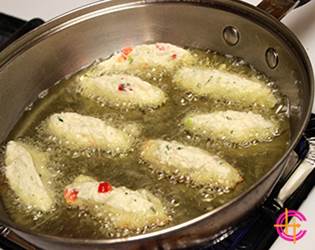
Remember plantation fires preceding the slave revolution, and start your deep frying on high flame. Form those oval beauties, drop them into boiling oil, and reduce heat to medium. It only takes about 3 – 4 minutes for them to acquire that gorgeous maroon color – reddish brown.
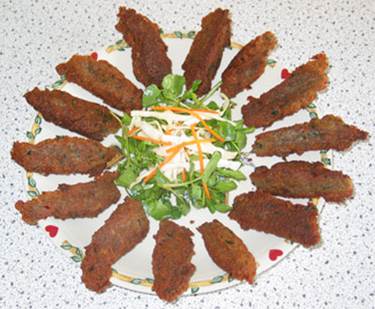
Serve your Accra with vegetables as an appetizer or a snack, or use it as a side dish to complement Haitian Baked Fish (Haiti, Part 1). Andrelle wishes you Bon Appetite!
INGREDIENTS
- 8 – 10 malanga roots
- 1/2 diced green pepper
- 3 – 4 garlic cloves
- 1 scallion
- 3 hot peppers
- Small bunch of fresh parsley
- 1 1/2 bouillon cubes or heaping tablespoon of pareve soup powder
- Salt and hot sauce to taste
PROCEDURE
- Peel and finely grate malanga.
- Blend the rest of ingredients into smooth paste. Add to grated malanga, mix thoroughly.
- Heat oil in deep frying pan, form oval fritters, drop into boiling oil, reduce to medium heat. Fry for 3 – 4 minutes or until reddish-brown.
- Remove to dish lined with paper towel to blot out excess oil.
- Serve with green vegetables.
Enjoy!

Reblogged this on Die Erste Eslarner Zeitung – Aus und über Eslarn, sowie die bayerisch-tschechische Region!.
LikeLiked by 2 people
Thank you for reblogging.
LikeLike
Thank you very much also for these fantastic recipe. Now its a challenge to get the malangan roots here in “bavarian siberia”. But at Munich (“Großmarkhalle”) maybe they are available. 😉 Have a nice weekend inside the sunny state. 😉 Michael
LikeLiked by 1 person
LOL ! I remember quite a few exotic foods being available in Munich years ago, so perhaps it is even more so now.
Thank you for your lovely comment, Michael!
LikeLiked by 1 person
Thank you for your efforts on your fantastic recipes. Now we see once again what we are missing here. ;-( Here are only potatoes and beer.;-)
LikeLiked by 1 person
My pleasure, Michael, and thank you for your kind words! Yes, I am familiar with beer and potatoes in Bavaria 🙂
LikeLike
Thanks so much for this share!
Here in Italy we can’t find fresh akkra , while yucca can be bought in lots of Markets….
I lived some months in Venezuela and I recall some wonderful recipes that , too bad, I can’t repeat at home….
I didn’t know about your history , though I’m aware of all the evil Europeans did to the new-discovered lands….
It’s a bit late to say : I’m so sorry………!
LikeLiked by 2 people
Thank you so much for your kind comment! It’s not my history, but my students’ history, but I feel for them, as I am sure you do.
You can make the same recipe with yucca, although it’s a little hard fine-grating it.
LikeLike
😌
LikeLiked by 1 person
🙂
LikeLike
This was a serious post with sad historical mistakes and horrors featured from Haiti. I am glad you bring them to the forefront. We must not forget. We all need to continue to be loving and accepting towards others from places we may never have been.
The recipe sounds delicious and the way you placed them on the plate made me think of a sunflower or a radiating sun with sunbeams. ~Robin
LikeLiked by 1 person
Thank you so much, dear Robin! With all my funky jokes, I am always dead serious about people suffering.
I am so glad you like the recipe, but the credit goes to my student Andrelle who shared both the recipe and the photos.
LikeLike
I so feel ashamed that my people’s “civilisation” contributed to the slave trade and decimation of other human beings. Maybe not so much my ancestors, as they were, up until my father’s generation, only peasants toiling other people’s land. Still.
Thank you (and your student) for another yummy recipe!
LikeLiked by 1 person
You are most welcome, and thank you for a lovely comment. Sadly, slavery is part of everyone’s history, and treating other human beings in all kinds of inhumane ways is, unfortunately part of history as well. Looking back, I can’t help but admire those who tried to fight the injustice.
LikeLiked by 1 person
I so agree, Dolly!
LikeLiked by 2 people
🙂
LikeLiked by 1 person
Sounds and looks interesting.
LikeLiked by 1 person
Thank you so much; I am so glad you like it!
LikeLiked by 1 person
I did
LikeLiked by 1 person
🙂
LikeLiked by 1 person
💌💌🙂😎🙂💌💌
LikeLiked by 1 person
Very interesting post… and the recipe sounds amazing. To bad I wont be able to get the malangan roots in ireland… 🤔😔
LikeLike
Thank you for your kind comment; I am so glad you like it. If you can’t get malanga, you can try the same recipe with parsnips or turnip.
LikeLiked by 1 person
Oh great idea. I will definitely try it then. Love parsnip anyhow 😊
LikeLiked by 1 person
Good luck, and please let me know how it comes out!
LikeLike
Oh i sure will… 😁
LikeLiked by 1 person
🙂
LikeLiked by 1 person
I’m loving this Caribbean series!
LikeLiked by 1 person
Thank you so much. The final and most important one is coming up – can you guess what it is?
LikeLiked by 1 person
I am not sure. Whatever it is will not be a sequel to the Pirates of the Caribbean. LOL! So, maybe it will be the extended strong rule of France over Haiti.
LikeLiked by 1 person
Oh no, quite the opposite!
LikeLiked by 1 person
Oh well, the opposite …hmmm! Maybe Ponce de Leon’s impact on Haiti.😕
LikeLiked by 1 person
I got your curiosity going, haven’t I?
LikeLiked by 1 person
I thought i had studied the Haitians pretty well in anthropology. I remember they are from the Dahomey tribe of Africa their French colonization, pirates wars and spanish influences… yeah you have me goin’!😟😕
LikeLiked by 1 person
Not only Dahomey, but also Yoruba and Ibu. In fact, voodoo seems to come from Yoruba, but this is a subject I really don’t want to touch.
LikeLiked by 1 person
Right! Finally all of the islands were used for harvesting potatoes, canes, bananas, and melons. (the answer is about food). I cannot speculate on religion, the fountain of youth, Columbus’s redirect for spices. I give up and resolve with the regional food grown on the plantations. 😟
LikeLiked by 1 person
…and coffee and tobacco. Yes, it’ll be about regional food, of course!
LikeLiked by 1 person
I suppose i am tired. i went everywhere to get there. 😕 The exporting of these products was really no economc relief for Haiti.😟
LikeLiked by 1 person
Very true, and I still hold that the greatest resource of Haiti is its people.
LikeLike
There isn’t really any notoriety of products from Haiti. Not Haiti’s wealth but America and Europe. This interferes with real attribution and association of Haitian produce.
LikeLiked by 1 person
Agree, but what do you think of Haitian coffee? It’s making its way to the organic market, at least here in South Florida.
LikeLiked by 1 person
Haitian coffee has many names. As an American or European distributed French Roast the market is more vast. But noted as a Haitian coffee a wider margin of distribution and marketing is in order.
LikeLiked by 1 person
You’re the expert – you know better. BTW, Part 3 is up https://koolkosherkitchen.wordpress.com/2017/06/26/the-real-treasure-of-the-caribbean-haiti-part-3-liberty-soup/
LikeLike
Reblogged this on koolkosherkitchen and commented:
Today’s word prompt,PROCLIVITY (https://dailypost.wordpress.com/prompts/proclivity/), speaks to me of the natural proclivity of Taino people, native to Haiti, to be friendly and hospitable. It speaks to me of the imported African slaves’ proclivity to fight for their freedom. Above all, I admire proclivity of my Haitian students to hard work and their dedication to learning. Here is Part 2 of my Haitian series. Enjoy!
Don’t forget, my book is found here:
https://amazon.com/author/koolkosherkitchen
LikeLike
This looks very inviting, Dolly 😀
I haven’t seen these roots here either, but we do have so many other kind of roots. I suppose, it can be made with those too.
LikeLiked by 1 person
Thank you so much, dear Irene! I am sure it can be made of any hard starchy roots. I haven’t tried, as we have malanga in abundance, but I’d be interested to find out.
LikeLiked by 1 person
What does Malanga taste like?? I know, like itself. lol
But what can you compare it to?
I love your food presentations!
LikeLiked by 1 person
Thank you, darling, but this was my student’s presentation – credit goes to her! Malanga could be compared to yucca, and don’t ask me what yucca tastes like! Both are hard and touch starchy root veggies. You are in Florida, you should have them in stores. 😻
LikeLike
Thank you for reblogging.
LikeLike
Excellent post and it’s great you provided some history…I literally grew up on “accra”, buying it on the street…best eaten with some spicy “picklliz”
LikeLiked by 1 person
I know all about “picklliz”! LOL Thank you for your kind comment!
LikeLike